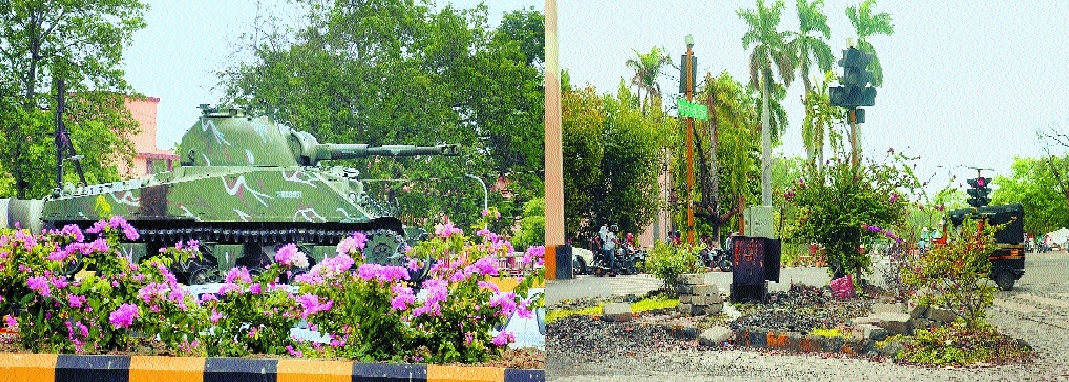This is Nagpur ... ... This, too, is Nagpur
| Date :10-Jul-2019 |

(left) Ajni Square (right) University Library Square
By Kartik Lokhande:
Sometimes, contrast explains a situation better. In case of Nagpur city of today, the above two photographs present that contrast and make a telling comment on the state of affairs. Of course, the beauty of island in which battle tank is mounted near Ajni Square on Wardha Road stretch and condition of island hosting the traffic signal near University Library represent just one part of the story. When it comes to story... Nagpur’s story has moved simultaneously from lull to growth and from organised to messy. Till a few years ago, several foreign delegations visited the city and got impressed with the infrastructure works in progress, and all the signs of growth story. However, the recent past has seen some of those foreign delegations not revisiting the city with an intent to invest. For, they have realised how haphazardly is the development being carried out in the city. Cement roads were constructed, but ramps were not for a long time. It took sustained campaign in ‘The Hitavada’ to awaken the authorities concerned from their slumber and get the ramps in place.
Still, at many places, including the plush Ramdaspeth area, the ramps to cement roads are in utterly bad shape. While constructing the roads, space was left for street-dividers with an intent to plant flowering varieties of plants and provide a scenic and pleasant look to the road. Sadly, barring Ajni Square and a few other places, the situation along the Ring Road and other stretches of roads is pathetic to say the least. For, the debris of construction were dumped in the ‘would-be street-dividers’. What will grow in these? Trees were choked in the haste of construction of cement roads or tarring. Again, it took the newspaper campaign to wake up the authorities concerned from their slumber. Some things moved, for a while.
Though in the civic administration’s admission, a few thousands of trees were dechoked, the photographs published by ‘The Hitavada’ showed how poorly had the ground-level manpower worked. In the name of dechoking, the roots of several big trees were left exposed. At many places, earth was not added at the tree bases. As a result, the dug-up portion was used by the equally insensitive lot of Nagpurians to dump garbage. The city of Nagpur once boasted of several lakes created by visionary rulers of yesteryears. Encroachments, dumping of garbage, unchecked growth of water weeds, and heaps of apathy have shrunk and are killing many of these wonderful water bodies. May it be Futala, may it be Gandhi Sagar, may it be Pandharabodi... And, then, people complain of depletion of groundwater level!!! The woes of the city, which is Second Capital of Maharashtra and an ‘emerging’ metro, are not restricted to these. There are issues of cleanliness and sanitation.
Though the authorities claim that the city has become ‘open defecation free’, there are stretches along railway tracks passing through some localities, slum areas, open and neglected spaces along Ambazari garden to Amravati Road stretch where signs of open defecation can be found any given day. It may be due to technical issues concerning soon-to-end contract of one agency and time taken in appointment of new agencies, as the civic authorities claim, there is no denying that many open spaces (at some places, plots) in the city have become garbage dumping points.
Then, there are ‘dark spots’ in the city. Several areas have street-lights that are not functioning. This makes it difficult, for two-wheeler riders and four-wheeler drivers to ride/drive safely in the night, particularly in rainy season. In monsoon, earth and sand get dumped on the roads. But, even that is not cleared by the authorities. In fact, they wait for the ‘regular thing’ -- of sand getting dispersed by passing vehicles. One may say that the authorities are working. Of course, some of them must be working hard. But, somewhere, there is lack of swiftness of action if one considers overall set-up. The lack of political leadership that can visualise a better future for the city -- in terms of cleanliness and sanitation, proper illumination, beautification, livability, smoothness of roads, proper management of traffic signals, well-maintained water bodies, safety and security for citizens -- is aiding that lack of swiftness on part of political leaders.
As a result, the administration and the city fathers wait for newspapers to take up issues and then respond. There is less evidence of a proactive approach adopted by the city fathers, except for announcing new projects of which feasibility is often not taken into consideration. As a result, various projects either get shelved silently or are put on backburner. Example? Orange City Street, construction of shopping complex in place of Mahatma Phule Market, etc. Unless the triad of political leadership, administration, and people come together with a common goal, the picture in contrast will be there. ‘This’ (beautiful) will be Nagpur... and ‘This’ (awful), too, will be Nagpur...